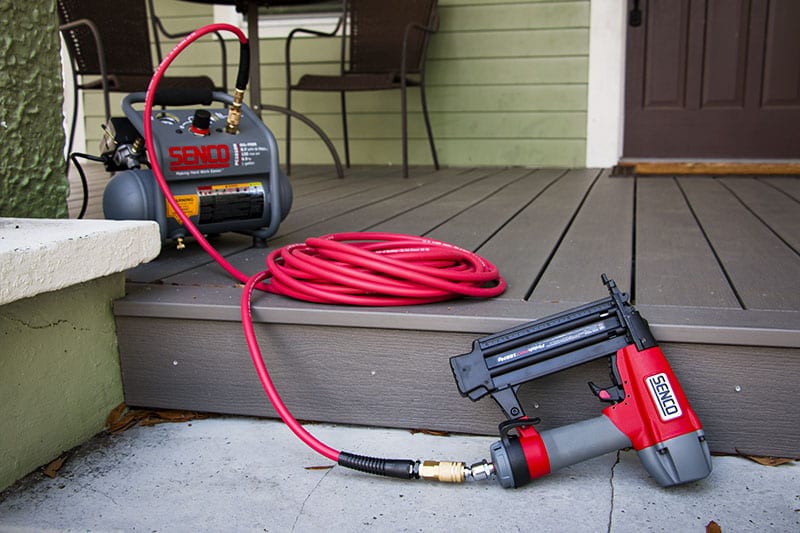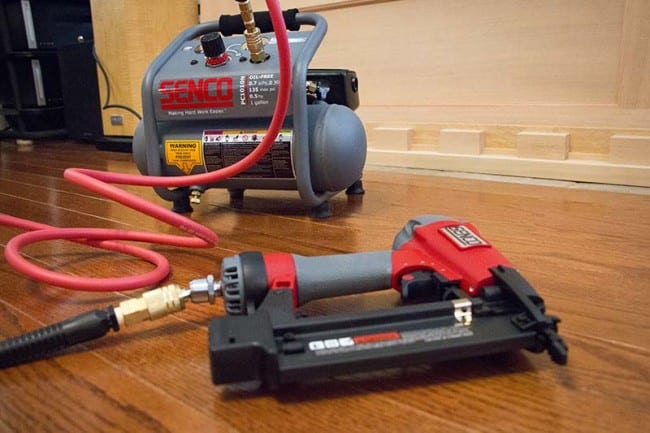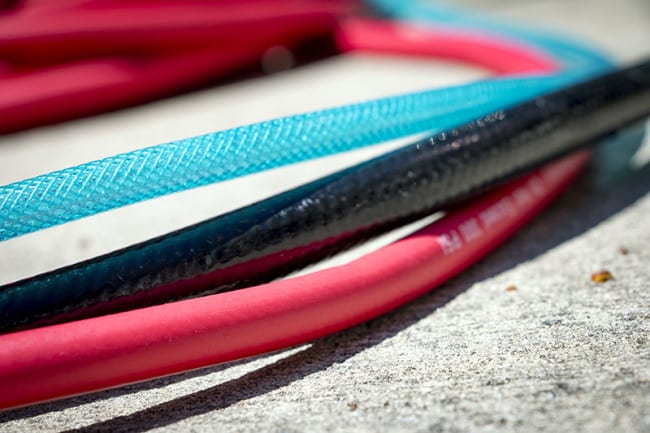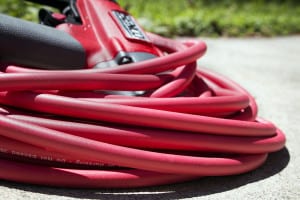Lighter, maintenance free nailers and compressors have dominated pneumatic innovation in recent years with little attention paid to the connection in between. After all, a hose is a hose, right? Need flexibility? Go with rubber. Need durability? Grab a PVC construction hose. Until recently, you had to make a choice. The new Senco Hybrid Hose is changing the game by offering a solution combining the best of both worlds.
The Senco Hybrid Hose is made possible thanks to the chemical geniuses working with polymers. Polymers in the hands of the right people are the custom kings of the chemical world. Their bonds are incredibly strong thanks to long chains. They can be adapted to a wide variety of flexibility and stiffness. They’re also also really tough – great for hoses, not so much for landfills. Rubber and PVC are both polymers by rights. While Senco’s polymer blend is proprietary, they’ve come up with a happy medium.
Senco Hybrid Hose Key Features
Along with being both flexible and tough, there are other benefits that come along with the Senco Hybrid Hose. For those that don’t have the relative comfort of working in a sub-tropical climate, the hose remains flexible in temperatures ranging from -40 to 150 degrees Fahrenheit. When under pressure, it lays flat and you’ll have a really hard time trying to get it to kink.
The hose can handle working pressures up to 300 PSI. It’s lighter than straight up rubber hoses and features a non-marring finish to help protect surfaces you’re working around.
The 1/4″ hose comes in lengths of 50 or 100 feet. Both sizes are also available with repairable hose ends to make on site repairs easier. The Hybrid Hose comes in between the price of rubber and PVC. You’ll pay $20 – $30 for 100′ PVC hose and around $60 for rubber. The Senco Hybrid Hose (PC1320) currently is running $45 – $50 online.
Senco Hybrid Hose Specifications
- Model: PC1319 – 50′, standard
- Model: PC1320 – 100′, standard
- Model: PC1321 – 50′, repairable
- Model: PC1322 – 100′ non-repairable
- Hose Diameter: 1/4″
- Max Operating Pressure: 300 PSI
- Operating Temperature: -40 to 150 Fahrenheit
- Fittings: FTP
Performance
We paired the Senco Hybrid Hose with the company’s new FinishPro 18BMG 18 gauge nailer with magnesium construction. On the other end, we had Senco’s PC1010N 1 gallon compressor to complete an excellent lightweight “grab and go” finish combo. Being in Central Florida, we aren’t about to see temps near -40, even in the freezer. We’re not looking forward to a 150 degree summer in spite of global warming either. We were looking forward to getting a few projects wrapped up at Clint’s house though.
The hose is rated up to 300 PSI, though we weren’t operating anywhere near that pressure for light finish work. We noticed that the hose was definitely heavier than the lightweight PVC hoses we generally drag around, but lighter than the rubber hoses in the shop. The flexibility of the hose is outstanding. We were able to easily roll it up to about an 18″ diameter circle without having to bind it. We didn’t have any trouble with kinking either. After all, no one likes a kinky hose.
One thing we noticed while dragging it around is how the rubber end of its personality shows up on its exterior. More like the uncoated rubber of a tire, there’s some friction to the chemical makeup. It can resist being dragged across some surfaces and pull on loose objects.
Working inside a home that doubles as a home school classroom, this meant that some of Caleb’s homework got eaten by the hose. Okay, not really, but it did drag his papers across the floor. As advertised, the finish left no marring on Clint’s hardwood floors, baseboards, or door casings as we moved around.
Normally, we’d think the frictional resistance to movement is where hoses lose their durability. Think tires peeling out on pavement – you have to wear down the tire to get it to slip. This is true with rubber hoses, but much less so with PVC. We drag hoses all over the jobsite when we use them, so having the PVC-like durability is going to be a major benefit.
Parting Shots
People are going to ask the question as to whether the Senco Hybrid Hose is worth it. Do its benefits really outweigh any trade-offs? It definitely has the flexibility of a rubber hose. Even though we didn’t go out of our way to see how much abuse it can take, it certainly seems to be resisting abrasion so far.
That boils it down to the the trade-off between flexibility and weight. If you’ve used both kinds of air hoses before, you know how useful the flexibility is for keeping the nailer balanced, especially if you’re not using swiveling couplers. The obvious trade-off is you still have a heavier hose than PVC even though it is lighter than straight up rubber.
Most professionals will likely view this as an improvement on the rubber hose for the added durability, lighter weight, and lower price. PVC is still going be the greater appeal for users looking to reduce weight (even though the stiffness is much greater) and get the lowest prices.






